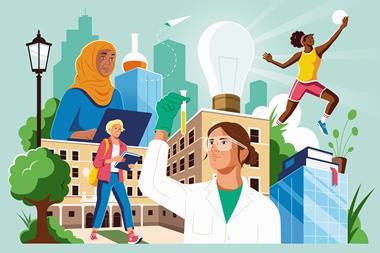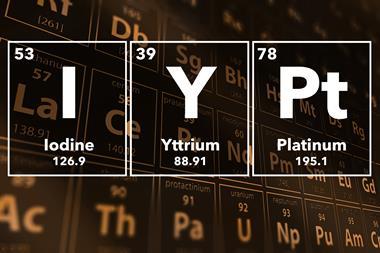The International Union of Pure and Applied Chemistry (Iupac) has released a new list of 10 emerging chemistry technologies that could have a huge impact on how we live. It’s no surprise that this year’s list focuses on the Covid-19 pandemic, but, while there are plenty of potentially important emerging chemistry technologies in healthcare, topics such as energy efficiency, pollution and climate change also make the cut.
1. Dual-ion batteries
While lithium-ion batteries won the chemistry Nobel prize in 2019, a new dawn is breaking for dual-ion batteries. Lithium-ion batteries made the miniaturisation of energy-storage devices possible, powering laptops, smartphones and electric vehicles. However, they have their downsides. Lithium and cobalt are relatively scarce and are associated with unsustainable mining. Dual-ion batteries could replace them.

Dual-ion batteries are batteries in which anions and cations participate in energy storage. Dual-ion batteries are greener than lithium-ion batteries as their electrodes can be produced from cheap and abundant materials. Researchers are trying to create cheap dual-ion batteries using non-toxic organic solvents, such as water and enhance sustainability. Chemists have also found new ways to produce these batteries using sodium, potassium or aluminium, resources that are far more abundant than lithium.
2. Aggregation-induced emission
Certain molecules release energy in the form of light when they aggregate with other molecules. This is called aggregation-induced emission, and it’s a phenomenon found in luminogens such as polyaromatic compounds and oligosaccharides. Researchers think aggregation-induced emission could find uses in new luminescent materials for OLED devices, sensors and novel bio-imaging tools.
3. Microbiome and bioactive compounds
Bacteria in the gut can make a wide range of molecules in response to different stimuli. Recent computational analysis of the genome of the microbiome has discovered a number of interesting molecules, including powerful antibacterial compounds.This finding serves to show how much there’s still to learn about the microbiome and how these discoveries could harnessed in medical research.
4. Liquid gating technology
Membranes controlled by liquid gates may sound absurd on the face of it, but this technology has already been demonstrated. Liquid gated membranes can respond to pressure changes, opening and closing pores on-demand without the need for electrical control. Liquid gates can be used to selectively process mixtures of fluids without clogging, so researchers foresee this technology being used in separation and filtration processes, for example, in water purification.
5. High-pressure inorganic chemistry
In the field of high-pressure chemistry, researchers apply intense pressures to a chemical and analyse its response. Under ultra-high pressure, the rules of chemical bonding alter and effects such as luminescence could be enhanced.
This field could lead to the discovery of novel properties in everyday chemicals, leading to the discovery of materials that are superconductors at room temperature, for example.
6. Macromonomers for better plastic recycling
Getting rid of ocean plastics is a task chemists are embracing from numerous angles. One of them is to redesign plastics, to craft more sustainable materials. Solutions include building plastics that break down under UV light or incorporating heteroatoms and functional groups in polymer structures, resulting in polymers that are easier to hydrolyse and recycle.

7. Artificial intelligence applied to chemistry
As in many other fields, artificial intelligence will improve the way in which chemists work. Researchers are developing algorithms to speed-up the understanding of chemical structures, enhance retrosynthetic analyses, design optimised reaction sequences and discover new drugs. Reactions could also become easier to reproduce and scale-up, while becoming greener and more efficient.
8. Nanosensors
A sensor detects changes in its surrounding environment. Chemical nanosensors detect a wide array of substances and, today, this field has progressed to the point where single molecules can be detected.
This technology could find applications in many areas and change the way we make decisions about the world around us. For example, in healthcare, detecting a specific protein could be a sign of disease. Nanosensors could also be used to search for specific molecules in food to determine whether a product is safe to eat or not.
9. Rapid diagnostics for testing
It’s thanks to chemistry that there are different types of tests that can detect many different chemicals. Yet, these don’t need to be just for detecting diseases – pregnancy tests are rapid diagnostic tests which detect a hormone.
Rapid tests for the detection of Sars-CoV-2 is an area of intense research currently. Some rapid tests detect RNA strands, while others look for antigens. However, the World Health Organization is not currently advising healthcare services to implement this type of testing globally as its effectiveness is still questionable. Developing rapid tests that can detect Covid and other diseases in a timely and effective manner is an ongoing challenge for chemists.
10. RNA Vaccines
The search is currently on for a vaccine that could end the global pandemic. Pharmaceutical companies, such as Pfizer, are working on a unique type of vaccines to fight Covid-19: RNA vaccines. The vaccine that was recently reported as 90% effective at preventing Covid-19 is RNA-based.

RNA vaccines are based on a synthetic mRNA for a viral protein making them quick to design and easy to scale-up. When an RNA vaccine is administered the mRNA is turned into viral proteins. The immune system response to these proteins can then confer immunity on the vaccine recipient.
However, no RNA vaccine has been approved in humans to date, but they are undoubtedly a promising path to fighting Sars-CoV-2.
This latest list of chemistry innovations follows on from Iupac’s one last year, released to mark its centenary. According to the organisation, these lists promote the fundamental role of chemistry in protecting society and the planet.

















No comments yet